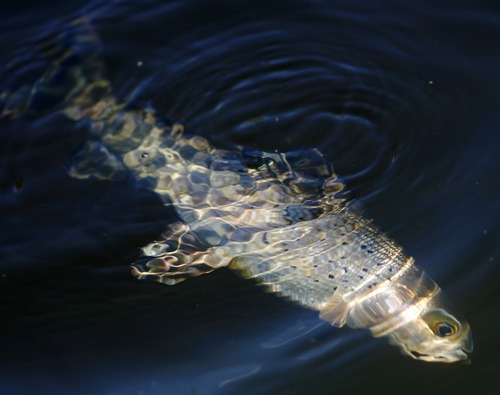This is an archived article that was published on sltrib.com in 2013, and information in the article may be outdated. It is provided only for personal research purposes and may not be reprinted.
Utah anglers will be able to keep two daily limits of fish starting in 2014, but will still be required to count fish stuffed in freezers when counting their total.
Spearfishers will have more places to "hunt" next year and anglers will be allowed legally to dispose of fish they are required to kill, after the Utah Wildlife Board approved recommendations Thursday from the Utah Division of Wildlife Resources (DWR) for the 2014 Fishing Guidebook.
Efforts by the Sportsmen for Fish and Wildlife (SFW) group to extend the possession limit to three days' worth of fish and eliminate processed (bottled) fish as part of that limit will be considered for another year, as the board elected to get more input from anglers regarding those changes.
Anglers are currently allowed to only have the daily limit of fish — four trout for average Utah fishers — in their possession. That means four fish on the stringer at the lake, in the cooler at camp or at home in the freezer.
"We were given a mandate [by the Wildlife Board] to think of incentives to attract people to more distant waters where we don't see a lot of pressure or have enough harvest," said Drew Cushing, warmwater sport fisheries coordinator for the DWR. "And at the same time not affect those places where we have adequate pressure and harvest."
The changes will not impact anglers at Strawberry Reservoir or Flaming Gorge Reservoir. For Strawberry, biologists elected to stay with one daily limit to maintain a lower level of angler harvest. Flaming Gorge is managed in conjunction with Wyoming so Utah officials will wait until that state has time to implement the new regulation.
Being able to keep more fish during a weekend excursion might lead to more anglers heading to out of the way waters, but Ken Strong with SFW says allowing three days' worth of fish limits will get more people to buy fishing licenses.
Strong pointed out to the board that when the state limit — which does not apply to all species on all waters – dropped from eight to four fish, the number of fishing licenses purchased in Utah dropped by more than 50,000. He also noted that other steep declines happened with other changes in regulations.
Jim Carter, a longtime angler advocate and founder of the Strawberry Anglers Association, countered that drops in license purchases have followed national trends in declines, spurred by issues like a stalled economy and local factors such as drought.
The Wildlife Board told DWR fisheries biologists to put the question to the angling community for review.
Spearfishing, a topic of heated debate the past few years, remains a thorny issue, but the board approved a list of more waters where the activity can take place. Spearfishing will not, however, be allowed at Jordanelle and Lost Creek reservoirs starting in 2014 and there will be some seasonal closures to protect spawning largemouth and smallmouth bass.
The new regulations did not sit well with some anglers.
"Spearfishing is actually freshwater hunting," said Clifford Sackett with the Utah Bass Federation. "Many states allow spearfishing in lakes and reservoirs, but nearly all of them restrict the divers to rough fish like carp, gar, bullheads, suckers and etcetera. Spearfishing is not fishing, it is hunting and it should be regulated under hunting rules, which is what a lot of other states do."
Utah anglers also got some direction when it comes to disposing of fish they are required to kill when caught in certain places, but may not want to take home. It won't be illegal for anglers to conk a northern pike they caught on the Green River on the head and then put it back in the river, although the fish is most often eaten in those cases.
Twitter: @BrettPrettyman



